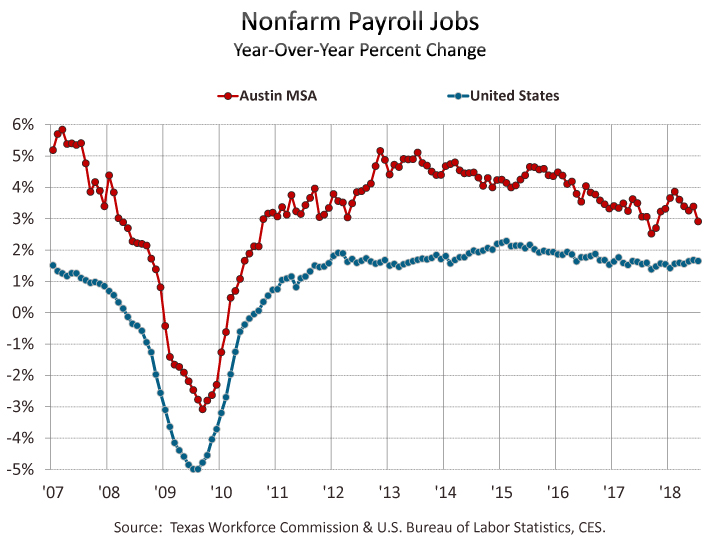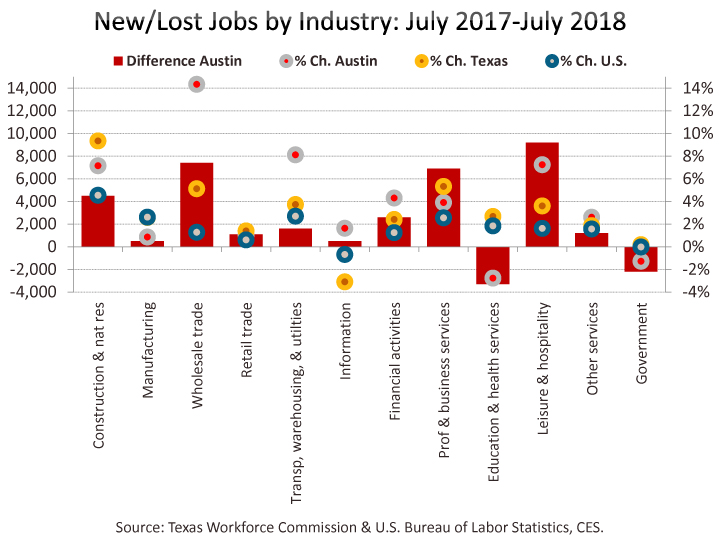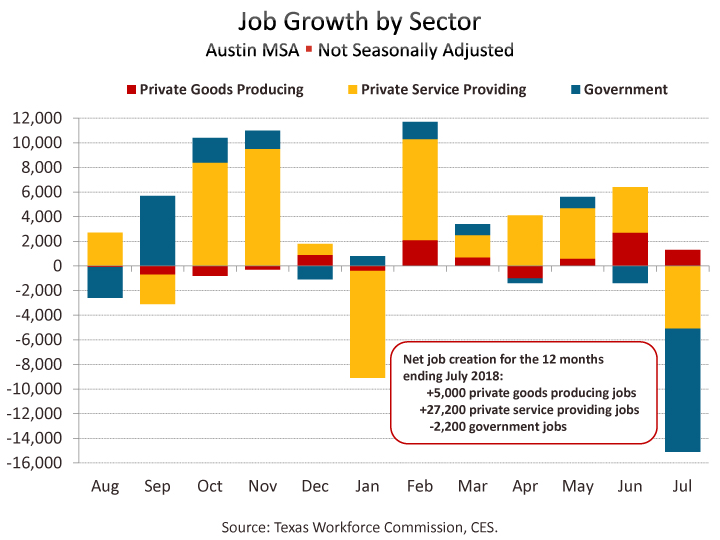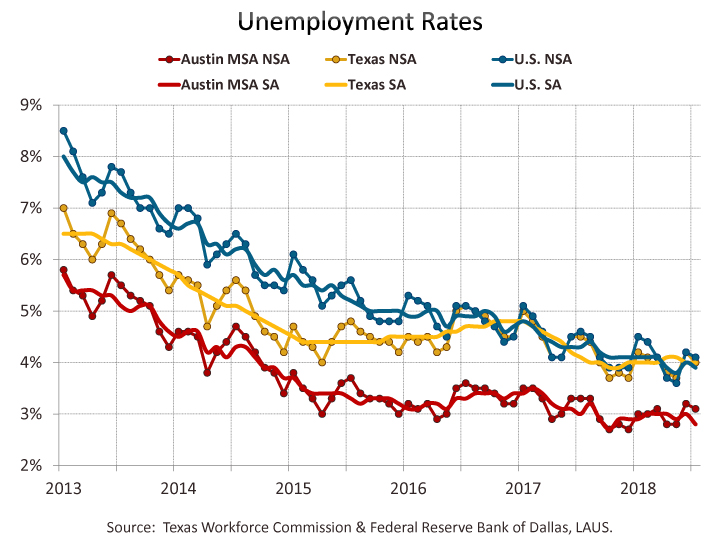Job Growth & Unemployment
Posted on 08/21/2018 by Beverly Kerr
- Austin added 30,000 net new jobs, growth of 2.9%, in the 12 months ending in July, making Austin the 11th fastest growing major metro.
- Wholesale trade was the fastest growing industry in the Austin MSA, increasing jobs by 14.3% (7,400 jobs) over the last 12 months. Leisure and hospitality added the most jobs—9,200 (7.2% growth).
- Austin's seasonally adjusted unemployment rate is 2.8%, down from 3.0% in June.
The Austin metropolitan area added 30,000 net new jobs, or 2.9%, in the 12 months ending in July, according to Friday's releases of preliminary payroll jobs numbers by the Texas Workforce Commission (TWC) and the U.S. Bureau of Labor Statistics (BLS).

Austin’s 2.9% growth makes it the 11th best performing among the 50 largest metro areas. Dallas and Houston, up 3.5% and 3.4% respectively, made the top ten. Fort Worth (up 2.8%) and San Antonio (up 1.3%) ranked 13th and 36th.

For the year ending in July, private sector job growth in the Austin MSA is 3.8%, or 32,200 jobs, with all private industry divisions, except education and health services, adding jobs. Austin's sizable government sector (over 17% of jobs) saw jobs contract over the last 12 months, losing 2,200 jobs or 1.3%, thus bringing the overall job growth rate to 2.9%. It may be noted that in a ranking of the top 50 metros based on private sector growth, Austin’s 3.8% growth would put it in a five-way tie for third fastest growing.[1]

Texas saw net private sector job growth of 3.7% with all private industries, except information, adding jobs over the last 12 months. Total job growth was 3.2% as the government sector, which accounts for 16% of total state employment, was up by only 0.2%. For the nation, private sector growth is 1.9% for the 12 months ending in July with all private industries, except information, adding jobs. Overall job growth is a more modest 1.6% because government sector growth was essentially unchanged.

Jobs in July are down from the preceding month by 13,800 jobs or 1.3% in the not-seasonally-adjusted series for Austin. In the seasonally adjusted series, jobs fell from June to July by 2,700 jobs or 0.3%. Seasonally adjusted jobs are up by 0.2% in Dallas and Fort Worth, 0.1% in Houston, and essentially unchanged in San Antonio. Statewide, seasonally adjusted jobs are up 23,500 or 0.2%. Nationally, seasonally adjusted jobs are up 0.1% from June.

In Austin, the industry adding the most jobs is leisure and hospitality which grew by 9,200 jobs (7.2%) over the last 12 months. The fastest growing industry is wholesale trade, which grew by 14.3% (7,400 jobs). Wholesale trade grew fastest, at 13.2%, and added 6,800 jobs. Also growing at faster-than-average rates are transportation, warehousing and utilities (8.1% or 1,600 jobs); construction and natural resources (7.2% or 4,500 jobs); and professional and business services (3.9% or 6,900 jobs). Education and health services jobs declined by 2.8% or 3,300 jobs. Click here for graphs of the 2012-2018 growth rate trends for the major industry groups.

Statewide, construction and natural resources grew fastest, at 9.3%, and created 88,000 jobs. Professional and business services added the most jobs, 88,900, while growing 5.3% over the last 12 months. The other relatively fast growing industry was wholesale trade (up 5.1%). Jobs declined in information by 3.1%.
Nationally, construction and natural resources grew fastest, adding 4.6% over the 12 months ending in July. Transportation, warehousing, and utilities (2.7%) and professional and business services (2.6%) were also relatively fast growing. Information jobs fell by 0.7%.

The net gain for private service-providing industries in Austin is 27,200 jobs, or 3.7%, over the last 12 months. Employment in goods producing industries is up by 5,000 jobs or 4.1%. Statewide, private service-providing industries are up 270,900, or 3.2%, and goods producing industries are up 110,200 jobs, or 6.1%.
We also now have July labor force, employment, and unemployment numbers for Texas and local areas in Texas. The same data for all U.S. metros will not be released until August 29. In June, Austin had the fifth lowest rate of unemployment among the 50 largest metros.
Unemployment numbers for July show Austin’s performance relative to the state and other major Texas metros being sustained. In July, Austin is at 3.1%, while the other major metros range from 3.5% in San Antonio to 4.4% in Houston. Dallas and Fort Worth are at 3.6% and 3.7% respectively. Austin’s rate one year ago was 3.3%. The rates in Texas’ other major metros are also each below the rates seen a year ago. The statewide not-seasonally-adjusted rate is now 4.0%, down from 4.5% in July of last year. The national unemployment rate is 4.1%, improved from 4.6% in July 2017.

Within the Austin MSA, Travis County has the lowest unemployment rate in July, at 3.0%, while Caldwell County has the highest at 4.0%. The rate is 3.1% in Hays County, 3.2% in Williamson County, and 3.8% in Bastrop County.
On a seasonally adjusted basis, Austin’s July unemployment rate is 2.8%, down from 3.0% in June. The statewide seasonally adjusted rate is 4.0% in July, unchanged from June, while the national rate is 3.9%, down from 4.0%.
Among Texas’ major metros, San Antonio has the next lowest seasonally adjusted rate at 3.2%, Dallas and Fort Worth are at 3.4%, and Houston is at 4.3%. July rates are lower than June in each metro. Seasonally adjusted unemployment rates for Texas metros are produced by the Federal Reserve Bank of Dallas. (The TWC also produces seasonally adjusted rates for Texas metros, but publication lags the Dallas Fed’s data.)

With the decrease in Austin’s unemployment rate from one year ago, the number unemployed has also declined. In July 2017, Austin’s number of unemployed was 38,072. Over the last 12 months, the unemployed have decreased by 1,513, or 4.0%, to 36,559.

The Austin metro’s civilian labor force (employed plus unemployed) has increased by 2.4% or 27,940 persons from one year ago, while persons employed increased by 2.6% or 29,453. Texas has also seen greater growth in employed (2.4%) than labor force (2.0%), and the number unemployed decreased by 47,611 or 7.9%. Nationally, July civilian labor force is up by 1.1%, while employed is above the level of a year ago by 1.6%, and 711,000 fewer people (9.6%) are unemployed. Click here for graphs of the 2012-2018 growth rate trends for labor force and employment.

The TWC and the BLS will release August estimates on September 21.
The Chamber’s Economic Indicators page provides up-to-date historical spreadsheet versions of Austin, Texas and U.S. data for both the Current Employment Statistics (CES) and Local Area Unemployment Statistics (LAUS) data addressed above.
FOOTNOTE:
[1] You may recall that Austin ranked second in the job growth ranking in our article about this data last month. Austin’s slip to 11th in this month’s top-50-metros ranking, while sustaining relatively strong private sector growth, prompted a closer examination of the government jobs series. Year-over-year growth of government jobs has been negative for the last 11 months after running consistently positive for the preceding five years.
Separate series for local, state and federal government employment are published for the Austin MSA. In examining these, it turns out that there has been a notable fall off in state government jobs (while federal and local government job growth has been positive). In 2017, jobs fell into a customary seasonal July-August trough, but instead of promptly rebounding, continued to hold at that level. This year, state government shed another 4,200 jobs in Austin between June and July, falling to 65,300. This is the lowest state employment figure for the Austin MSA since August of 2006. In 2016, the metro's annual average state government employment was close to 75,000.
For Texas, state government detail is published for educational services (this subtotal is not reported for the Austin MSA). Statewide, government educational services growth has been positive, while year-over-year job growth has been negative for other state government functions since May 2017. This circumstance might point to the state government hiring freeze that was in effect from January through August of 2017 as potentially relevant to what has happened to state jobs. According to press reporting, while public universities were included in the freeze, positions not funded by state appropriations were exempt and only about 30% of money going to Texas’ public universities is state funding.
Therefore, state agency offices, rather than the metro’s state universities, may be where many of Austin’s state government jobs were shed from. Although the hiring freeze has ended, the state is in the challenging position of filling job openings while local private sector industries are expanding and unemployment is low. Click here for several graphs illustrating state government employment.